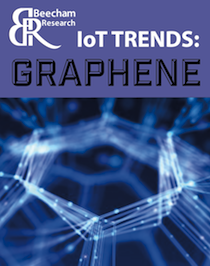Graphene – a wonder material for future IoT applications

At Mobile World Congress 2016, in Hall 8.1, the last hall in the endless Catalan event, immediately close to the IoT Pavilion, there was a section dedicated to graphene, strongly supported by the EU Graphene Flagship. The Graphene Flagship (http://graphene-flagship.eu/) is the second largest Future and Emerging Technology Flagship programme by the European Commission aiming to bring together academia and nanotechnology industry and moving graphene from laboratories into real applications. The programme was launched in 2013 with an investment of €1bn. This substantial investment is illustrative of the importance of graphene and nanotechnology. As for the IoT vision, the graphene embraces a transformational vision that impacts all areas of society, write Dr Therese Cory, senior analyst and Saverio Romeo, prinicipal analyst at Beecham Research.
What is Graphene?
Graphene is made of carbon atoms, just like graphite and diamond. However it was only discovered in 2004 by scientists at the University of Manchester. A graphene sheet consists of a single, two dimensional layer of carbon atoms just one atom thick in a honeycomb structure.
Graphene has a range of remarkable properties: exceptional strength, elasticity, an excellent conductor of electricity and heat, and the ability to sense a range of parameters from humidity to pressure, temperature or light. Printed electronic circuits made of graphene can be made by an inkjet printer.
Graphene and IoT Applications
These properties give it a number of potential applications, including:
- Ultra-thin displays and touch screens
- Transistors
- Solar panels
- Remote sensing applications including Internet of Things in the realms of biomedicine, wearables, environmental air quality sensing and so on..
A layer of graphene can be bonded to a substrate– for example plastic or textile – hence providing a substrate for wearables and printed RFID tags.
Cambridge University researchers have suggested that graphene’s low energy consumption, together with the ability to support extreme data speeds will make it the material of choice to support new communications technologies, from high-speed 5G wireless data networks to Internet of Things applications.
The EU Graphene Flagship works along different directions, called Divisions. Within each Division, there are a number of research streams. The most relevant one for the IoT community are: sensors, biomedical technologies, electronic devices, photonics, flexible electronics, and wafer scale system integration. Therefore, the breadth of impact of graphene on the IoT could be extremely wide. Several examples of this extensive work can be found on the Graphene Flagship website. There are also national research initiatives in various countries and in specific areas such as healthcare and materials.
Graphene for smart healthcare
In 2015, University of Manchester researchers received a major grant to extend their graphene work. The team will examine how one-atom-thick materials – including graphene – could be combined to create designer materials, fine-tuned to meet the demands of industrial and commercial applications. So far they have shown that low cost, flexible, wireless graphene communication devices such as healthcare monitors can be directly printed into clothing and even skin. They have demonstrated its suitability for wearable electronics applications, such as smart, battery-free healthcare and fitness monitoring, Internet-ready devices and chargers to be incorporated into clothing and ‘smart skin’ applications.
For remote healthcare, printed graphene sensors integrated with other 2D materials may be attached to a patient’s skin to monitor a range of parameters such as temperature, strain and moisture levels for example. South Korea’s Institute for Basic Science (IBS) has been developing a wearable graphene based patch; the device integrates electrochemically active and soft functional materials on a hybrid of gold-doped graphene and a serpentine-shape gold mesh. This collects parameters from the sweat of the wearer, allowing diabetes sufferers to be accurately monitored. Diabetes represents a significant health hazard in the country, with some three million Koreans affected.
Graphene for smart materials
Currently, there are many methods being utilised and developed to prepare graphene sheets of various dimensions; however there is as yet no way to mass produce layers of graphene of sufficient quality for many of the electronic applications mentioned above.
Researchers at the National Physical Laboratory (NPL) in London are contributing to the development of a global graphene industry; their aim is the successful commercialisation of this material, leading to its industrial production and adoption. The NPL is also involved in the development of international standards for graphene that will support its long term future exploitation in all of the areas above.
In summary, Graphene’s physical properties will enable scientists to design materials that never existed in nature, with properties that never existed in nature. Its unique properties, not the least being its low energy consumption, together with the ability to support extreme data speeds, will render it useful in many new IoT applications.